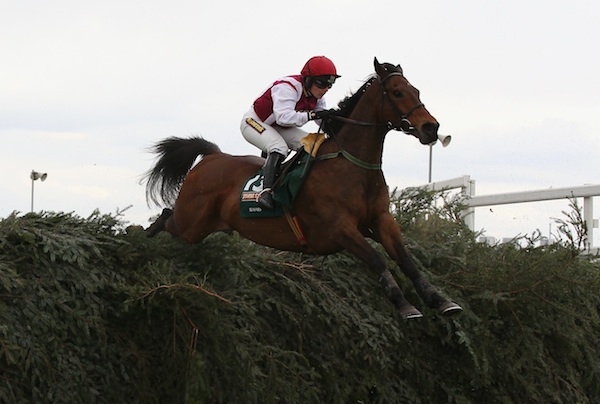Nothing hurts quite so much as the ones that get away. Unable to be at Cheltenham’s Festival the day the improving Holywell, one of this column’s Twelve to Follow, was running in the Pertemps Final, I had assumed I would be able to phone in my bets. Alas, where I was I had no access to a laptop and my phone went dead. Holywell, partnered as usual by the admirable Richie McLernon, ran a blinder to win ahead of Captain Sunshine and Jetson. The good news for those Spectator readers who have stuck with this winter’s selections was that his victory was secured at the heart-warming price of 25–1.
I can only hope for better luck with the upcoming Grand National, and with Irish trainer Willie Mullins having blitzed the Cheltenham Festival with no fewer than five winners, I am hoping that his luck continues. I backed his Prince de Beauchene for last year’s National and didn’t get a run after he was injured. I have backed him again for this year’s contest but with Willie’s other runner, On His Own, now the favourite for the race you can still get the 12–1 I got two months ago. I was a little disappointed with Prince de Beauchene’s prep race at Fairyhouse in February when he was beaten by Roi du Mee but as Willie said, ‘He ran a bit with the choke out, a bit fresh,’ and he was satisfied.
The National being the National, I have ante-post wagers on two others. Welsh trainer Evan Williams has shown that he knows exactly what is needed to get a horse into the frame at Aintree. From 2009 to 2011 he had State of Play in the first four and then last year Cappa Bleu finished third. At Ascot in February Cappa Bleu ran what was for me the perfect trial behind Vino Griego, and when I approached Evan afterwards for his verdict on the performance he looked at the heavens and with biting emphasis simply enunciated two words: ‘One day. One day.’ I got 20–1 against Cappa Bleu’s prospects that day and he is still available at 14–1 to provide his much-underrated pilot Paul Moloney with a National winner. My third hope is David Bridgwater’s Wyck Hill, who disappointed in the King George after being purchased by J.P. McManus but who turned out to have suffered a bad cut in the race. He is a big fellow who should take to the National fences but, thanks to that Kempton performance, my 20–1 on him now looks miserly as you can back him anywhere at 33–1. Interestingly Bridgy rates him better than his The Giant Bolster who ran fourth in the Gold Cup but as I write they are still assessing if Wyck Hill has recovered sufficiently to run.
We will all be praying this year that we can concentrate before and after on the racing rather than the politics. The animal rights activists were in full cry after last year’s triumph for the grey Neptune Collonges because tragically that year’s Gold Cup winner Synchronised and According to Pete both had to be put down afterwards. Once again racing in general and Aintree in particular were under the wrong kind of spotlight. The penalty of a race that uniquely has 12 million viewers is its appeal also to propagandists, and the RSPCA, which has often in the past worked sensibly with racing’s authorities to maximise safety, came out all guns blazing labelling Becher’s Brook a ‘killer fence’ and demanding its scrapping. In fact, Synchronised broke a leg while running riderless half a mile after Becher’s. True, According to Pete broke his off-fore when falling at Becher’s but in fact he jumped it well and simply had nowhere to go because On His Own had fallen ahead of him. The irony is that ‘improvements’ to Becher’s following past protests probably did for him. What the professionals tell you is that easing Becher’s has made jockeys less fearful of the fence. Instead of fanning out across the course to tackle it they now go faster and crowd in. That, it seems, is what unsighted On His Own.
Since last year’s race, three more drop fences have had their landing areas levelled out and to calm the cavalry charge of 40 horses to the first fence the start has been moved 90 yards closer to it, taking jockeys and horses away from the adrenalin-inducing hubbub in the stands. Much more sensibly, the Aintree fences are now being built around plastic cores rather than timber posts, which can prove a fearsome obstacle on the second circuit when first-round fencers have kicked the spruce off them.
All that is fine, but unless some genuine practical concern is revealed by this year’s contest we must surely stop there. The whole point of the National is that it is different — longer, more demanding and, yes, a little riskier. Implement too many more ‘reforms’ and there simply won’t be any point, it won’t any longer be the National and there will be no reason for those 12 million to tune in.





Comments